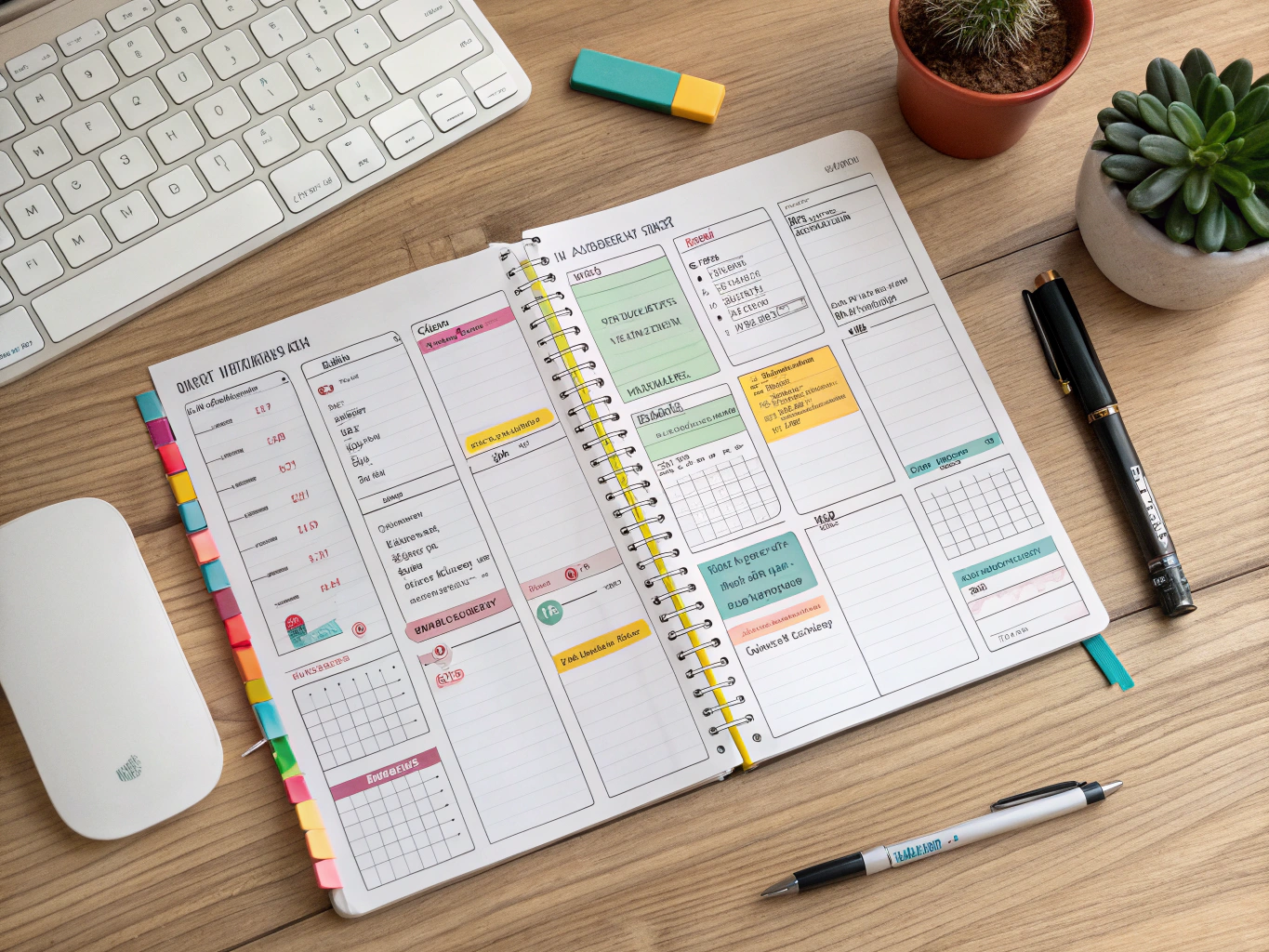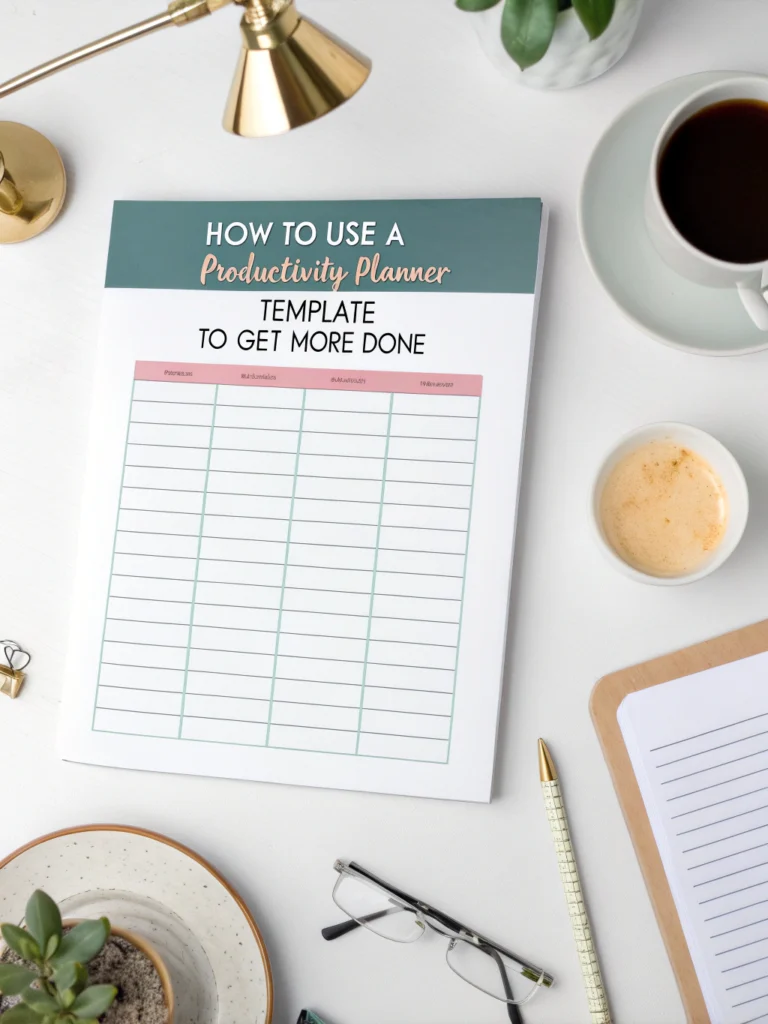How to Use a Productivity Planner Template to Get More Done
Ever feel like you're constantly busy but not really making progress on what matters most? That's where a productivity planner template comes in. I started using one last year and it completely changed my work life.
A good productivity planner template isn't just another to-do list – it's a strategic framework that helps you prioritize, focus, and actually finish what you start.
Why a Productivity Planner Template Actually Works
Most people try to organize their day with random notes or basic to-do lists. But here's the truth:
Lists don't distinguish between what's important and what's just urgent.
A proper productivity planner template forces you to make those critical distinctions. When I switched from my chaotic system to a structured planner, my output literally doubled in two weeks.
The magic lies in how these templates combine:
- Priority setting
- Time blocking
- Progress tracking
- Reflection tools
Let's break down how to use one effectively.
Key Components of an Effective Productivity Planner
Before diving into how to use a planner, you need to understand what makes one effective:
- Top Priorities Section – Space to identify your 1-3 most important tasks
- Time Blocks – Pre-scheduled chunks for focused work
- Progress Metrics – Ways to measure completion
- Reflection Area – Space to evaluate what worked and what didn't
The best planner templates for efficiency combine these elements in a simple, accessible format.
How to Use Your Productivity Planner Template (Step-by-Step)
Let me walk you through exactly how I use mine:
1. Morning Planning Ritual (10 minutes)
I start each morning by identifying my top 3 priorities. Not everything on my to-do list – just the 3 things that will move my business forward most significantly.
This is the core of effective daily productivity planning.
Here's what I write for each priority:
- The specific task
- Why it matters (connects to larger goals)
- Estimated time needed
- When I'll tackle it (time block)
This prevents the common mistake of filling your day with busy work rather than progress.
>AI for Productivity eBook + Checklist: Supercharge Your Efficiency in 21572. Time Blocking Your Day
Next, I schedule specific blocks for each priority task. This is non-negotiable time – I close email, silence notifications, and focus completely.
Most productivity planner templates include time block sections. I typically schedule 60-90 minute focus blocks followed by short breaks.
Pro tip: Schedule your most challenging mental tasks when your energy peaks (for me, that's early morning).
3. Quick Wins & Small Tasks
After prioritizing the big stuff, I allocate time for smaller tasks. I batch similar activities together:
- Email/communication block
- Administrative tasks
- Quick decision items
This batching approach is one of the most powerful productivity tips 2025 has to offer – it minimizes context switching, which kills momentum.

4. Regular Check-Ins
The secret to making a planner work is actually using it throughout the day. I create three checkpoints:
- Mid-morning review
- After lunch assessment
- End-of-day evaluation
During each check-in, I mark progress and adjust as needed. The best time management tools encourage this kind of continuous engagement.
5. End-of-Day Reflection
This is the step most people skip – but it's where the real growth happens. I spend 5 minutes asking:
- What did I complete?
- What didn't get done and why?
- What adjustments would make tomorrow better?
These insights help continuously improve my planning approach.
Best Productivity Planner Template Options for 2025
While the specific template matters less than how you use it, here are some formats I've found especially effective:
Digital Planners
- Notion templates (customizable and sync across devices)
- Desk productivity tools that integrate with digital planners
- Apps that combine time management tools with planning features
Paper Planners
- The ADHD-friendly productivity method planner (structured but flexible)
- Bullet journal templates (creative and adaptable)
- Time-block specific templates (best for deep work sessions)
I personally use a hybrid approach – digital for team collaboration and paper for my personal focus sessions.
>ADHD Productivity Power Pack: Ebooks, Guides, Checklists, Workbook & Tools to Master Focus, Time Management & OrganizationCommon Mistakes When Using Productivity Planners
Let me save you some pain by sharing the mistakes I made:
- Overplanning – Scheduling every minute creates anxiety, not productivity
- No buffer time – Things always take longer than expected
- Ignoring energy levels – Not all hours are equally productive
- Forgetting the why – Tasks without purpose feel meaningless
- Not reviewing – Planners gather dust if not regularly assessed
The best productivity tips 2025 has to offer is to start simple. A basic template used consistently beats a complex system used sporadically.
How to Customize Your Planner for Maximum Impact
Ready to take your planning to the next level? Here's how to customize your templates:
For creative professionals:
- Add inspiration tracking
- Include idea capture spaces
- Use visual progress indicators
For managers:
- Add team alignment sections
- Include delegation tracking
- Create meeting prep spaces
For entrepreneurs:
- Include revenue-generating activity tracking
- Add customer touchpoint logs
- Create space for opportunity notes
The best way to boost productivity at work is to make your planner reflect your specific role and challenges.
Advanced Productivity Planner Strategies
Once you've mastered the basics, try these advanced techniques:
The 2-Minute Rule
If a task takes less than 2 minutes, do it immediately rather than planning it.
Theme Days
Dedicate entire days to specific types of work (e.g., "Meeting Monday," "Writing Wednesday").
Energy Mapping
Track your energy levels for 2 weeks, then schedule your most demanding tasks during your peak periods.
These approaches complement any productivity planner template by addressing the human element of productivity.
Productivity Planner Template FAQs
How is a productivity planner different from a regular planner?
A productivity planner focuses specifically on output and results rather than just scheduling. It includes prioritization tools, focused work blocks, and reflection components that regular calendars don't have.
How long should I spend planning each day?
Start with 10-15 minutes each morning. As you get more efficient, you can often reduce this to 5-10 minutes while achieving better results.
What if my day gets completely derailed?
This happens to everyone! The reflection component of a productivity planner template helps you analyze what went wrong and adjust. Sometimes the most productive thing you can do is adapt to changing circumstances.
Should I use a digital or paper planner?
This depends on your work style. Digital planners excel at integration and reminders, while paper planners create more mental commitment and eliminate digital distractions. Many people (including me) end up with a hybrid approach.
How do I avoid feeling overwhelmed by my planner?
Start simple – focus only on identifying 1-3 priorities each day and blocking time for them. Add more complexity only after this basic habit is established.
Final Thoughts: The Real Power of Productivity Planning
A productivity planner template is ultimately just a tool. The real transformation happens when you develop the habit of intentionally directing your time and attention.
The best planner templates for efficiency create a framework for this intentionality – they make you pause and think before diving into your work day.
I've found that the simple act of planning creates mental clarity that lasts throughout the day, making decisions easier and focus deeper.
If you're feeling scattered or overwhelmed, start with a basic productivity planner template tomorrow morning. Identify your top 3 priorities, block time for them, and reflect on what worked. That simple process will put you ahead of 90% of people when it comes to daily productivity planning.
Your ability to plan effectively isn't just about getting more done – it's about making sure what you accomplish actually matters.

